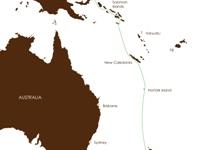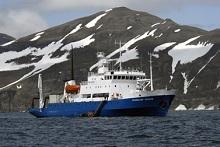Recently Viewed Cruises
- Enderby, Western Pacific Odyssey ex Lyttleton to KaviengAdd to favourites
- Hanseatic, (INT) Deep Insights into Myth of Amazon ex Iquitos to BelemAdd to favourites
- Bremen, (INT) Where the Course is Determined by Longing ex Auckland to LautokaAdd to favourites
- G4, Galapagos Cruise ex Quito ReturnAdd to favourites
- G3, Galapagos Voyage ex Quito ReturnAdd to favourites
- Catch up on Cruising: Latest cruise news in bite size
- Oceania puts the flags out for Insignia
- Luxury cruising booms
- Catch up on Cruising: Latest cruise news in bite size
- Royal Caribbean International raises the bar
- Frequently Asked Questions
-
Enderby, Western Pacific Odyssey ex Lyttleton to Kavieng
Nights 19 Ship Spirit of Enderby Star Rating Specialty Departs Christchurch (Lyttleton), New Zealand Sailing 2013: 25 Mar Ports of Call Christchurch (Lyttleton), Kaikoura, Norfolk Island, Noumea, Rennell Island, Soloman Islands, Honiara, Kolombangara, Papua New Guinea, Kavieng Please enquire about this cruise for pricing.
18 Night Cruise sailing from Lyttleton to Kavieng aboard Spirit of Enderby. 1 night hotel stay post-cruise in Kavieng.
This year's Western Pacific Odyssey commences in the South Island Port of Lyttelton, Christchurch, where historically this voyage has commenced in either Auckland or Tauranga. Departing from this new location gives us a rare opportunity to see and photograph some of the Southern Albatross and petrels not seen on previous Western Pacific Odysseys.
From Lyttelton we will cruise up the east coast of the South Island to the famous Kaikoura Trench - a world renown pelagic 'hotspot' and then through Cook Strait, another well known pelagic birding area, and into the Tasman Sea. On the journey from Lyttelton to the Tasman Sea we could potentially view four more species of greater albatross, five species of the smaller albatross (Mollymawks) plus a number of other petrels and prions.
From Cook Strait the journey through the Tasman Sea takes us to Norfolk Island where we rejoin the traditional itinerary to New Caledonia and onto the Solomon Islands, here we will spend four exciting days birding on a few of the islands in this little South Pacific archipelago. The Solomon Islands comprise of 992 islands, of which 147 are inhabited. They stretch 1448 kilometres (900 miles) in a south-easterly direction from the Shortland Islands, on the border with Papua New Guinea, to the Santa Cruz Islands, which borders Vanuatu.
The main islands of the Solomon's are volcanic in origin, covered with dense tropical forest with fast flowing rivers and streams. They are home to many endemic flora and fauna species.
In the Solomon Islands we plan to land on the heavily forested Kolombangara Island before we cruise the coasts of the islands of Bougainville and New Ireland, Papua New Guinea.
PNG as it is widely known, is home to many rare bird species, most famously 38 species of birds of paradise. Our journey ends at the town of Kavieng, New Ireland, well known for its white sandy beaches and fantastic coral reef dive locations.
Day 1: Port of Lyttelton
Arrive into the city of Christchurch and transfer to the Port of Lyttelton where you will join the Spirit of Enderby. After settling into your cabin you will be introduced to your Expedition Team and there will be some on board safety briefings. The ship will depart this evening.
Day 2: Kaikoura and the Cook Strait
We will arrive in the early morning off the shore of the small fishing village of Kaikoura, made famous with its whale watching and pelagic birding tours. There will be no landings here, however, the ship will cruise along the Kaikoura Trench, known by many birders for the albatross species seen here. We will be looking for certain species in particular including Gibsons, Southern, Northern Royal and Salvins Albatross, Westland and White-chinned Petrel.
Days 3 to 5: At Sea
En route to Norfolk Island, we have a good chance of spotting Gould's Petrel, Black-winged Petrel, White-naped Petrel, Grey-faced Petrel, Tahiti Petrel and Black Petrels.
Day 6: Norfolk Island
After clearing Australian Customs, we aim to spend most of the day at Norfolk Island's Botanical Gardens, home to the two endemics- the Norfolk Island Parakeet and the Norfolk Gerygone.
Day 7: At Sea
We will spend the next day at sea on a northward course. We cross a large underwater seamount, a productive area for seabirds including Tahiti, Kermadec and Grey-faced Petrels, plus the first of the Polynesian Storm Petrels.
Day 8: At Sea
Today we plan to look for the 'New Caledonian Storm-Petrel' which has been seen almost annually from the Spirit of Enderby since it was first discovered on our Western Pacific Odyssey expedition in 2008. Some excellent photos of this mystery bird were taken in 2012 confirming suspicions that whilst it resembles a New Zealand Storm-Petrel, it is not this species and is seemingly to be an unidentified species.
Whilst searching for the storm-petrel will be our priority, other possibilities in this area include Magnificent Petrel, White-bellied Storm-Petrel, as well as Tahiti, Gould's and Collared Petrels.
Day 9: New Caledonia
In the early morning we pick up our pilot for the journey into the Port of Noumea and travel to the Parc de la Rivicre Bleue.
Located 60 kilometres from Noumea, the provincial park of the Blue River occupies an area of 9,045 hectares, its purpose to protect and conserve the natural heritage, provide recreation, education and scientific research facilities.
Home to many bird species they include New Caledonia's national bird, the Cagou (or Kagu). We will look for Kagu and Crow Honey-eater. Other birds to be on the lookout for include the Crested Parakeet, Cloven-feathered Dove, Yellow-bellied Robin, New Caledonian (Goliath) Imperial Pigeon and many more.
Days 10 to 12:At Sea
We will be able to enjoy these leisurely days at sea. There will be a series of lectures from our experts, or you can simply relax in the ship's bar, catch up with some reading in the library or have a sleep in your cabin. If you have brought your laptop with you, there will be time to download and edit photos while they are fresh in your mind.
Day 13: Rennell Island
The southernmost of the Polynesian islands in the Solomon Island group, a raised coral atoll, 86 kilometres long and 15 kilometres wide, Rennell is the largest example of this in the world. With the largest freshwater lake in the Pacific, Te Nggano attracts a unique habitat for many endemic bird species and is a nominated site for World Heritage status.
This morning we will go ashore at Rennell Island where we hope to see the Rennell Starling, Rennell Shrikebill, Bare-eyed White-eye, Rennell Fantail and Rennell White-eye. Other species we may come across include the Imperial Pigeon, Silver-capped Fruit Dove, Singing Parrot, Melanesian Flycatcher, Cardinal Myzomela, Finsch's Pygmy Parrot and Island Thrush. There is the chance to experience the culture and interact with the locals and possibly a snorkelling opportunity.
Day 14: Makira Island
Makira Island is located in the eastern Solomons. It is the most easterly of the main islands in the archipelago covering an area of almost 3100sq kilometres. A mountain range runs through the centre of the island. The harbour at Kirakira is considered to be the best in the Solomon Islands.
This island holds its own treasures, including the endemic Sooty Myzomela, San Cristobal Melidectes, White-collared Monarch, Mottled Flowerpeckers, White-headed Fruit-Dove and Rufous Fantail. Other species could include Rainbow Lorikeets, Red-knobbed Imperial-Pigeon, San Cristobal Singing and Metallic Starling, Pied Goshawk, Pacific Baza, and Cardinal Myzomela. We will also enjoy the hospitality of the people in nearby Anuta Village, where the colours are vibrant and welcoming, and the children always inquisitive and interested in visitors.
Day 15: Honiara
We will anchor off Honiara and depart in the early morning for nearby Mt. Austin. Birds that we might see include Yellow-eyed, White-bellied and Solomon's Cuckoo-shrikes, Cicadabird, Brown-winged and Singing Starlings, Yellow-faced Myna, Chestnut-bellied and Black-and-white Monarchs and also the Steely Blue Fly-catcher.
From the top of Mt. Austen there is a spectacular view out to sea and across the mountain ranges. The location of the Henderson Airfield and its surrounds was one of the key focal points of attention, during World War II.
Day 16: Kolombangara Island
We will hopefully make a landing at Kolombangara Island in the early afternoon. Here we hope to see White-capped Monarch, Solomon White-eye, Yellow-vented Myzomela and hopefully, the Roviana Rail. Other species could include Blyths Hornbill, Superb Fruit Dove, Red-knobbed Imperial-Pigeon, Steely Blue Fly-catcher, Melanesian and Yellow-eyed Cuckoo-shrikes, Metallic and Singing Starlings and the Solomon Sea-Eagle.
Day 17: At Sea
Having departed the Solomon Islands we will spend time over a deep water canyon near Bougainville-New Britain Trench. Experience tells us that it is a very productive area and we hope to see Heinroth's Shearwater.
Day 18: New Ireland
To the north-east of mainland Papua New Guinea lies the mysterious and beautiful New Ireland Province. New Ireland is the long narrow island north of New Britain. We will spend the day cruising off the coast, where our target for the day is the Beck's Petrel. Other species could include Wedge-tailed and Streaked Shearwaters.
Day 19: Kavieng, New Ireland
Arriving in Kavieng, Papua New Guinea we disembark from the Spirit of Enderby. Situated at the northern tip of New Ireland, Kavieng is nestled against a beautiful harbour surrounding islands ringed with sandy beaches and coral reefs. Spend the day this area where the ancient art of shark calling is practiced. Tonight we will stay in a hotel for our final night together before passengers disperse the following morning.
Day 20: Port Moresby
It is an early start today with an early morning transfer to Kavieng airport. Daily flights leave for Port Moresby to allow you to connect with international flights.







